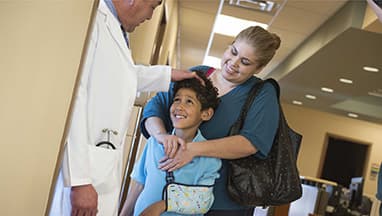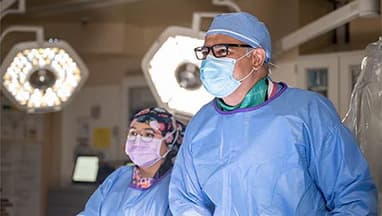Visiting Hours & Policies
Presbyterian welcomes visitors and knows how important family, close friends and support persons are to the healing and recovery of patients. Our visitation hours are from 8:00 AM to 8:00 PM. After 8:00 PM, visitation access for special circumstances will be considered. Please access the facility through the emergency room (ER) for consideration. In general, asymptomatic adults, support persons and children over the age of 14 are welcome, based on patient preference. We strongly recommend the use of medical-grade masks for ALL visitors and masks are available at inpatient and outpatient entrances. However, some departments or units have specific requirements to keep patients safe. (See the grid below for the details of each department/unit.) Staff will let patients and family/support persons know if a different visitor guideline is needed.
Families and designated support persons are welcome to be part of the care process and are respected as part of the care team. We thank you for partnering with the care team in keeping your loved one safe.
Children over the age of 14 with no respiratory symptoms are welcome and the use of medical-grade masks is highly recommended. Some areas in our hospitals and clinics will require a mask for visitation for the safety of our patients. Staff will let you know where a mask is required and we ask you to follow these requirements.
During respiratory disease season, children under 14 are not allowed as visitors. The length of respiratory disease season varies each year. Staff will let you know when masks are required. Exceptions can be made if the child is asymptomatic during extreme circumstances. All exceptions must be approved by the attending physician in collaboration with the nurse leader.
Family members opting to remain overnight are asked to partner with the care team and:
a) Remain in patient's room during QUIET HOURS, from 11 PM- 5 AM. Our goal is to limit hallways traffic to promote our patients restful sleep, essential to their recovery to good health.
b) For everyone’s safety we ask that you call the nurse for assistance should your loved one need bathroom privileges, our team is specially trained to help with mobility in these new surroundings.
The number of visitors for each patient depends on specific unit or department policies. Most of the time, only one (1) visitor may stay with the patient overnight. Nursing staff can work with patients and their families and support persons if there are special visiting needs. Any visitor staying overnight should be respectful of other patients and families who share the same semi-private room.
Specific Area Visitation Guidelines During Regular Visiting Hours
Specific Area | Visitor Policy |
|---|---|
Adult Inpatient | Two (2) support persons/visitors are welcomed at a time.* (Talk to the nurse leader if you have special needs.) |
Adult Intensive/ Critical / Cardiac Care Units | Two (2) support persons/visitors are welcomed at a time.* (Talk to the nurse leader if you have special needs.) |
Pediatrics non-ICU | The family should talk about visitation with the bedside nurse or charge nurses for their infant or child.* One (1) parent per patient is welcome to stay overnight. |
NICU | The family should talk about visitation with the bedside nurse or charge nurses for their infant. Two (2) visitors per patient at one time, one of whom will have a patient identifier band.* There are no in-unit sleeping arrangements for parents. Brothers and sisters may visit patients while following NICU guidelines. |
PICU | The family should talk about PICU visits with the bedside nurse or charge nurse for their infant or child.* Up to four (4) visitors per patient are welcomed in the PICU Visitors’ Lounge. Other visitors must wait in Main Lobby waiting areas. One parent per patient is welcome to stay overnight. |
Labor & Delivery/ Family Birthing Centers/ Mother & Baby Care/ Maternal Special Care Units | The number of visitors welcomed in the birthing room is decided by the patient’s wishes, but no more than four (4) visitors at a time.* Only one (1) visitor is welcomed in triage, operating and recovery areas. |
Behavioral Health Unit – Adult and Child/Adolescent at Presbyterian Kaseman Hospital | Unless prior arrangements are made, the visiting hours are: Monday to Friday 6:00 p.m. – 7:00 p.m. Saturday and Sunday 3:00 p.m. – 5:00 p.m. Two (2) visitors are welcomed at a time. |
Emergency Departments including PresNow locations | Two (2) visitors per patient in the patient room. One (1) visitor elsewhere in the emergency department (hall beds, waiting room, etc.). At times, the number of visitors may be limited or asked to wait outside, due to the limited seating in the lobby or patient waiting room spaces. |
Hospice Inpatient Unit at Presbyterian Kaseman Hospital | Visitation hours are 24 hours a day, seven days a week; two (2) visitors are welcomed at a time.* Visitors may alternate with others upon exiting the facility, but not more frequently than every two hours. Visitors must log in at the nurse’s station before visiting a patient. |
PMG Clinics and Physician Office Buildings | Two (2) visitors/ support persons are welcomed at a time. A support person may accompany the patient to departments if help with walking or motility is needed. |
Hospital Outpatient Departments | Two (2) visitors/ support persons are welcomed at a time. A support person may accompany the patient to hospital outpatient departments if help with walking or motility is needed. |
Surgery & Surgical Preoperative Areas | One (1) adult visitor may accompany patients for scheduled surgeries. Visitors should wait in available lobby space while the patient has surgery. |
Post Anesthesia Care Unit – PACU (Recovery Room) | Parents of pediatric patients are welcome to visit in the Recovery Area. One (1) visitor may visit adult patients in the discharge area ONLY of the PACU. |
*Visitors to patients with a diagnosis of COVID-19 will be offered masks or personal protective equipment (PPE) and instructed how to wear this equipment. Note that wearing PPE by visitors is an important infection control measure when visiting a COVID-19 patient, but it does not guarantee visitor safety and may not prevent the visitor from contracting COVID-19.



